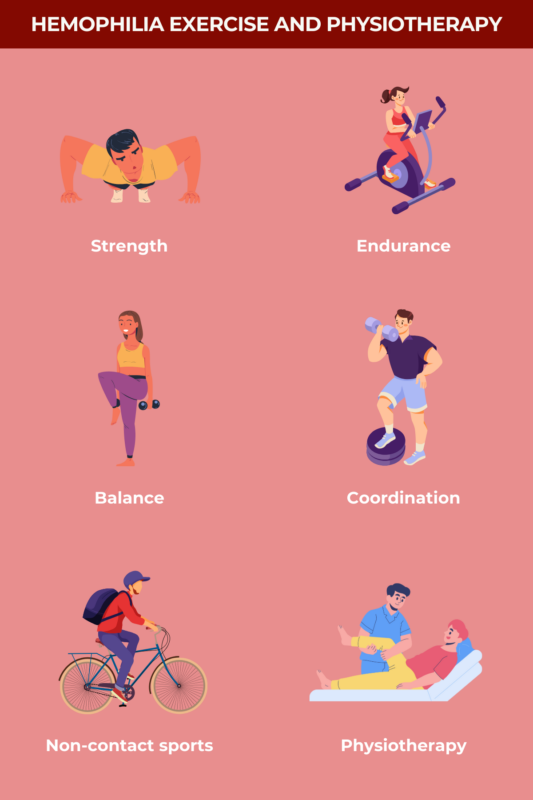Exercise and physiotherapy for people with hemophilia
Exercising regularly can provide many benefits for people living with hemophilia, including increased bone and joint health, stronger muscles, and improved cardiovascular health. In addition, physiotherapy can improve flexibility and movement, while also helping people manage their pain.
One of the main hemophilia symptoms is excessive bleeding, which can lead to joint damage, or joint arthropathy. This can limit movement for people with hemophilia and make it more difficult to exercise.
Thanks to prophylactic hemophilia treatments — in which, for example, concentrated clotting factors are injected to prevent bleeding episodes — children and young adults who have hemophilia are now less likely to develop joint damage than adults with the disease who didn’t have this treatment as children. This has opened up many options for physical activities and the World Federation of Hemophilia recommends those with hemophilia participate in regular exercise and play non-contact sports.
A physiotherapist can tailor an exercise program to a person’s preferences and interests. They can discuss risk management, highlight the importance of optimizing safety when playing sports, and provide rehabilitation and pain relief after an injury.
Benefits of exercise for people with hemophilia
The World Federation of Hemophilia’s guidelines on hemophilia management recommend regular physical activity to increase bone and joint health, build stronger muscles, and support cardiovascular health, healthy body weight, and positive self-esteem, among other benefits.
Before prophylactic treatments were introduced around the 1990s, exercise wasn’t always considered an option.
Physiotherapist Julia Brooks has worked with pediatric hemophilia patients for more than two decades and remembers the advice given about managing hemophilia and exercise when she first started.
“Prior to having prophylaxis as the standard of care, we told our patients to sit, and not move, or do anything, or they might bleed,” says Brooks, who works at a children’s hemophilia clinic in Alberta, Canada. “But it became clear that not doing any exercise makes you weaker, and that means you’re more likely to bleed.”
Bleeding into the joints can damage joint cartilage, so preventative treatment is started when a child is 1 to 2 years of age, says Brooks. This means young people don’t reach adulthood with severe joint pain or possibly needing joint replacements.
For people with hemophilia, exercise can:
- help manage chronic pain
- help maintain flexibility and balance
- improve coordination and reflexes
- increase blood flow to help heal damaged tendons, cartilage, and bone
- Increase bone mineral density.
Exercise also can help develop social skills, a sense of belonging, and boost mental health and confidence.
Brooks says 95% of her patients are male, including teenagers who are interested in trying many different types of sports.
“Because our kids are living with a chronic disease, that adds a mental health component that’s complex. Teenage boys struggle with wanting to do what their friends are doing,” says Brooks. “So, we work with them. We know it’s essential to keep our kids moving and to have them in peer relationships that will stick around as they get older.”
Colleen Jones Down, the clinical lead physiotherapist with a children’s hemophilia center in Newfoundland, Canada, says exercise should be tailored to the individual, based on their level of body awareness and ability to perform the exercises safely.
“For example, a young child may be given different exercises than an adult, to achieve the same goal,” says Jones Down. Typical exercises include stretching, strengthening, balance, core stability, endurance, neuromuscular control, and functional strengthening.
Strength exercises
Strength training exercises can help develop muscle strength to safeguard and reinforce the joints, which can reduce the risk of bleeding episodes that occur in all hemophilia types, including hemophilia A and hemophilia B.
Examples of exercises that can help build strength include:
- Exercises that use resistance bands are a controlled and low-impact form of strength training. They can be used for exercises such as bicep curls, lateral raises, and leg presses.
- Seated dumbbell exercises, such as shoulder presses or bicep curls, can be done while sitting on a chair or bench, and can help minimize the risk of falling.
- Bodyweight exercises are a safe way to build strength, including squats, lunges, push-ups, and bodyweight rows. These types of exercises engage multiple muscle groups without putting excessive stress on the joints.
Exercises that help build endurance include:
- using an elliptical machine or a recumbent bike to get a cardiovascular workout with minimal impact on the joints
- low-impact aerobic exercises like walking or stationary marching can improve cardiovascular health.
Balance and coordination exercises
Balance training can help build core muscle strength and improve posture. A good posture minimizes balance issues, leading to better mobility and fewer accidents.
Exercises that help build balance and coordination include:
- Stability ball exercises, such as stability ball squats or stability ball wall sits, can help improve balance and strengthen the lower body.
- Yoga and tai chi help with balance and coordination by incorporating single-leg stands and walking balance movements.
- Functional exercises replicate the movements used in specific sports, such as moving from side to side to prepare for skating, doing lateral shuffles to prepare for tennis, or stepping over a low obstacle course to increase agility.

Exercising safely
Until recently, exercise for people living with hemophilia was divided into risk levels, labeled like a traffic light.
- “Green” activities were considered safe, such as swimming or yoga.
- “Yellow” activities, such as playing baseball or tennis, could be done with caution.
- “Red” activities that involve contact like taekwondo or football, or high speeds such as dirt bike racing or snowmobiling, were to be avoided.
Thanks to preventative treatments, people with hemophilia can explore more activities than they could in the past.
Brooks uses a shared decision-making process, in which the person with hemophilia, their family, and their healthcare team talk through the benefits and risks of doing a desired activity.
“Many of our patients with mild hemophilia can forget they have it, because they’re not dealing with bleeds all the time,” she says. “So we came up with a contract. They take a look at a sport, at how injuries might happen, to decide if they want to participate. And if they do get injured while playing, we don’t say ‘I told you so.’ Instead, we get them into rehab, support them, and talk about how they can return to that sport, or if they might want to try something else.”
Brooks advises avoiding activities that could result in a neck or head injury.
“We talk about how, if you get a bleed into a joint in your neck or inside your head, that could be life-threatening,” she says.
When participating in sports like downhill skiing or soccer, Brooks recommends having an emergency plan in place in case of injury and a factor replacement therapy kit handy for immediate use. It’s important to let the coach, family, and friends know about having hemophilia and what to do in case of injury.
“We have lots of kids now that play basketball at a very high level. I have a kid who’s an international soccer player. We have kids that are skiing,” she says. “We have lots of patients pushing the limits of what we thought was possible.”
Parents of school-age children with hemophilia need to ensure school personnel — such as physical education teachers — are aware of the child’s bleeding disorder, and any first aid measures, in the event of an acute bleed, says Jones Down. This is particularly important if the child is young or if the injury makes them unable to communicate.
“The child also needs to be educated in self-management, so they can advocate for themselves in the event of a bleed,” says Jones Down.
Brook’s advice for minimizing the risk of injury is to always consult a physiotherapist familiar with bleeding disorders before starting exercise, to learn the proper form, and to know how long to do it and at what intensity.
Exercise tips
To stick with an exercise plan and make it more likely to become a long-term habit, select activities that are enjoyable and align with personal interests.
Choose activities that are low-impact and joint-friendly, such as swimming and stationary cycling, which are less likely to cause a bleeding episode.
A fitness professional familiar with hemophilia can design a personal exercise plan, provide proper instruction on technique, and monitor progress.
Exercise with a friend, family member, or a support group. Having a workout buddy can provide motivation, accountability, and an added layer of safety.
Watch for any signs of discomfort, pain, or unusual sensations during or after exercise, stop doing the activity, and consult with healthcare professionals.
Benefits of physiotherapy for people with hemophilia
Physiotherapy is used to evaluate one’s physical health, and then design and implement a safe exercise program for a person with hemophilia.
A physiotherapist will consider a person’s flexibility, strength, neuromuscular control, balance, and endurance. They can offer advice and training for safe participation in physical activities.
“We discuss risk management and help families with decision-making around safe participation in activities and sports and strategies for safe participation,” says Jones Down.
Hemophilia physiotherapy might include education about warm-up and cool-down routines, appropriate exercise intensity, and the importance of listening to the body. The physical therapist can make modifications to exercise techniques or help select activities that are gentler on the joints.
Hemophilia News Today is strictly a news and information website about the disease. It does not provide medical advice, diagnosis or treatment. This content is not intended to be a substitute for professional medical advice, diagnosis, or treatment. Always seek the advice of your physician or other qualified health provider with any questions you may have regarding a medical condition. Never disregard professional medical advice or delay in seeking it because of something you have read on this website.
Recent Posts
- Why someone else’s weight struggles are a private matter
- New gene therapy reduces bleeding rates for hemophilia B patients
- Hympavzi boosts quality of life for hemophilia patients in trial
- When women with bleeding disorders show up for each other
- In our family, we each play a role in navigating hemophilia
Related articles

 Fact-checked by
Fact-checked by 


